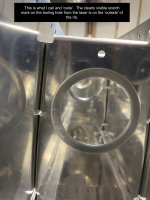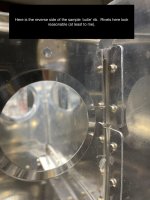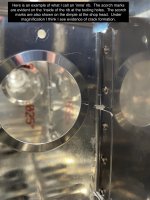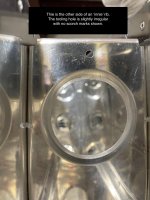scsmith
Well Known Member
To help get the various conversations about Laser-Cut Parts organized better, I am starting this on a new thread, and I deleted the post in the original thread. Note some serious edits here in this version also.
I just read the Engineering Assessment Document.
It talks a lot about fatigue characteristics, and useful life vs loads, all the classical stuff. But it seems to me that there is a problem with the analysis and assumptions, at least as presented in the document.
"Normal" fatigue analysis predicts the life of a part that starts out as a good part. It likely has stress risers, small defects that will eventually initiate a fatigue crack. A large fraction of the useful life occurs with no crack. At some point, a crack is initiated, and over time, grows to the point where the part fails. The portion of the useful life of a part once the crack forms is, I believe, fairly short compared to the portion of the life prior to the emergence of the crack.
So I'm not convinced the analysis and assumptions and testing presented in the document is meaningful for the case where a part begins its life with a crack.
Further thoughts:
I hope I did not give the impression that I thought that the Vans analysis, testing regimen and assumptions are improper. I'm sorry if I did give that impression. My point was only that the document itself didn't convey to me that they had considered the differences in fatigue characteristics when there is a pre-existing crack. I'm sure they did -- they are good, smart engineers, and it would always be the goal of the analysis and testing to replicate as closely as possible the actual circumstances under study.
By its nature, the Engineering Assessment Document is an overview, attempting to convey the scope and detail and rigor of the work they are doing. At the same time they have to provide enough background info so that folks can understand why it is that the testing is meaningful. Thus the general overview discussion about classical fatigue life testing and analysis.
I imagine that letting the 'public' in on intricate details of testing and analysis is a two-edged sword. But it would be interesting (to me at least) to have more insight into the particular test specimens that they are testing. I was hoping the document might have more of that. But I think we should have confidence that the testing they are doing IS meaningful and representative enough to draw engineering conclusions from. It wouldn't make sense for the company to make the investment to do the tests if they weren't.
I just read the Engineering Assessment Document.
It talks a lot about fatigue characteristics, and useful life vs loads, all the classical stuff. But it seems to me that there is a problem with the analysis and assumptions, at least as presented in the document.
"Normal" fatigue analysis predicts the life of a part that starts out as a good part. It likely has stress risers, small defects that will eventually initiate a fatigue crack. A large fraction of the useful life occurs with no crack. At some point, a crack is initiated, and over time, grows to the point where the part fails. The portion of the useful life of a part once the crack forms is, I believe, fairly short compared to the portion of the life prior to the emergence of the crack.
So I'm not convinced the analysis and assumptions and testing presented in the document is meaningful for the case where a part begins its life with a crack.
Further thoughts:
I hope I did not give the impression that I thought that the Vans analysis, testing regimen and assumptions are improper. I'm sorry if I did give that impression. My point was only that the document itself didn't convey to me that they had considered the differences in fatigue characteristics when there is a pre-existing crack. I'm sure they did -- they are good, smart engineers, and it would always be the goal of the analysis and testing to replicate as closely as possible the actual circumstances under study.
By its nature, the Engineering Assessment Document is an overview, attempting to convey the scope and detail and rigor of the work they are doing. At the same time they have to provide enough background info so that folks can understand why it is that the testing is meaningful. Thus the general overview discussion about classical fatigue life testing and analysis.
I imagine that letting the 'public' in on intricate details of testing and analysis is a two-edged sword. But it would be interesting (to me at least) to have more insight into the particular test specimens that they are testing. I was hoping the document might have more of that. But I think we should have confidence that the testing they are doing IS meaningful and representative enough to draw engineering conclusions from. It wouldn't make sense for the company to make the investment to do the tests if they weren't.
Last edited:








